
|   |

|   |
 e-mail: leelakaverivenkat@gmail.com Encouraging the young generation of dancers December 19, 2019 It is either everything or nothing when it comes to performance opportunities for a dancer in India. Performance space has been cornered by a handful of dancers who in most cases have had the good fortune to combine talent with power to influence the right decision making forces. Make no mistake; the latter has a big role to play in the scheme of things. What happens within the Guru/shishya teaching and learning arena remains largely outside reflection in the performance circuit. Which is why Ashok Vajpeyi, under the Raza Foundation umbrella of activities, very astutely started Uttaradhikar series for the young dancers, many of who would seem to struggle endlessly for platforms to perform. He is providing a regular platform (at least once a month) but on the recommendations of the Guru, who ultimately will be judged on the basis of the student's calibre. Two day events feature one promising young musician and one dancer every evening. 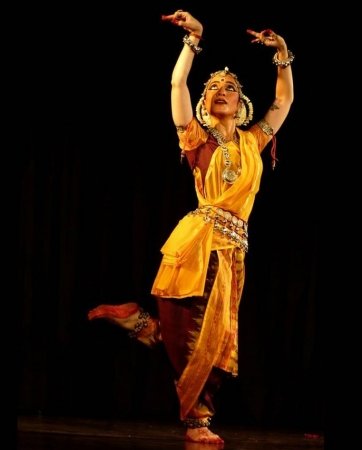 Madhyama Segal (Photo: Avinash Pasricha) This edition of Uttaradhikar on Nov 29 at the IIC Deshmukh auditorium, Delhi, had Odissi dancer Kiran Segal present her granddaughter Madhyama Segal. And it was gratifying to see how much this dancer has evolved since one last saw her. The starting Mangalacharan with Adi Shankara's prayer on Krishna as the sruti part, showed the balanced body and very neatly held postures, following Guru Mayadhar Raut's choreography, before moving on to the Pallavi in Hamsadhwani, a music composition by Satyanarayana Maharana with the dance set by Kiran Segal. The isolated torso movements so much a part of Odissi, in Kiran's style, fashioned on her training under Guru Mayadhar Raut, is quicker and one saw this in the very opening line of the music. And set to Jhampa tala of ten matras, the entire Pallavi moves in a gait which is different from most Pallavis in the Ektali rhythm. And Madhyama is extremely well equipped in technique to handle nritta with ease. In the ashtapadi "Rase Harimiha vihitavilasam", again choreographed by Kiran Segal, one got a picture of lonely Radha describing the Raas of Krishna sporting with the Gopis. With nature courting the right mood in all her bloom ("sanchara dadhara sudha madhura dhwani") Radha in her solitary state presents a contrast. The starting line "Viharati vane Radha" reflects this in brief. While the Raas part brought out the sporting of the Lord and the Gopis vividly, the contrasting starkness of Radha's loneliness, one felt could have been brought out a little more strongly in the way the ashtapadi was choreographed. And Madhyama's still evolving abhinaya has to develop that urgency in communication. Watching 'Jago Maheswara,' a music composition by the great Balakrushna Das, one could not keep away the mental pictures emerging from the past, of Kiran herself presenting this item with a communicative power, which few other students of this Guru have equalled. On Shiva, the supreme ascetic carrying the Ganga on his matted locks, this work of the Guru evokes a kind of power in quietude, which comes with mature abhinaya - which Madhyama should be able to express with time. Seeing the enormous strides she has made makes one feel that she is a dancer to watch out for. One was sorry to miss the other dancer in this series, namely Sneha Chakradhar, a very proficient Bharatanatyam disciple of Geeta Chandran. Indradhanush of dance forms 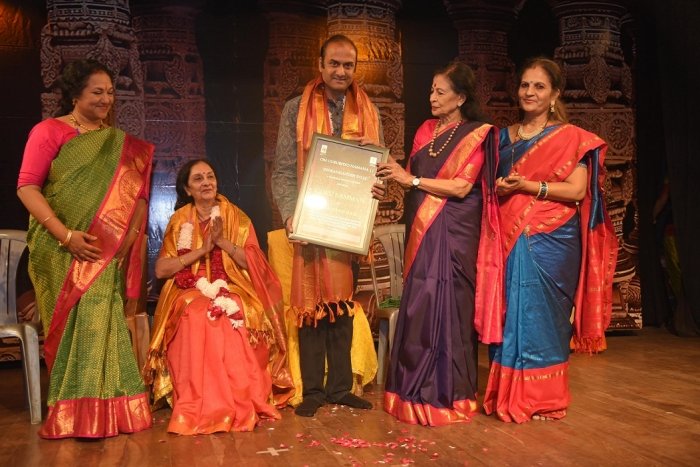 Kanaka Sudhakar, Geetanjali Lal, Santosh Nair, Saroja Vaidyanathan At the Muktadhara auditorium was Sambhav featuring a rainbow (Indradhanush) of dance forms, a festival by Nrityabharati designed by dancer/choreographer Kanaka Sudhakar -- which this writer unfortunately was able to visit only one evening with so much happening in town. Apart from featuring young and upcoming dancers, were eminent names, with the festival presenting those who are knocking at the doors of recognition alongside those who have arrived, and not forgetting in the process promising youngsters who are yet to catch the eye of impresarios. The event also bestows titles and tributes on dancers using their art forms in the service of the people, like Alpana Nayak, whose society in Delhi is working with Odissi for the differently abled youngsters, and it is heart warming to see how much joy she is bringing into many lives coming from this section of society, for which she was conferred the Parasmani award. The Guru Samman went to the Kuchipudi teacher Guru Seetha Nagajothy, a senior disciple of Guru Vempati Chinna Satyam, to Kathak Guru Geetanjali Lal, to Santosh Nair, Contemporary Dance performer and teacher running Sadhya, and to Carnatic musician Dr. T.V. Manikandan. Also finding space in the weeklong event to tickle the mind was a discussion on dance subjects in a seminar featuring Sahitya Kala Parishad research scholars on subjects like Shilpachakras of Delhi (Rahul Dev Prasad), Lost Dances of Uttarakhand (Kishore), Contribution of Delhi Gharana to Hindustani music (Subodh Pandey) and Position of Arts in Education (Shruti Krishna). Apart from all this was the Bala Nritya Samrat title as a recognition for the tiny tots showing unusual promise, which went to R. Aditya (a girl) for Kathakali and to Mrunmayee, Ratheesh Babu's daughter. 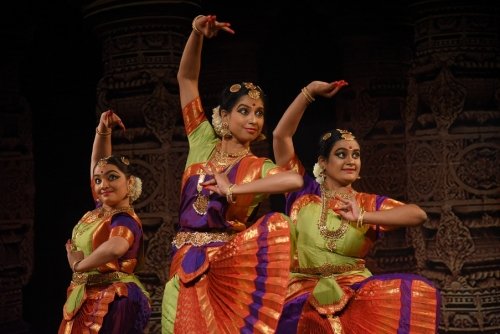 Students of Nrityabharati While this critic missed the evening when Kanakar Sudhakar's own students performed, it was interesting to watch a video of their Bharatanatyam performance based on a group presentation of a rare Ata Tala Ragamalika Varnam composed by R. Muralidharan, 'Saamagaana Priye, Sadashiva Nataraja varam arul." To judge by the video, all five participants Aparajita Sarma, Upasana Gagneja, Praharhini Vadlamani, Poornima Shyamsundar and Anusha Ramachandran, all highly trained dancers combined with skill and involvement. Not too many varnams in this talam and the varnam seemed well set. One is sorry to have missed a live performance on stage for a full idea. The third day's performance part started with Bharati Shivaji, the Mohiniattam guru and dancer, presenting in her highly graceful fashion, Bala Ganapati, a manifestation of young Ganapati very special to Kerala. This was followed by the chollukattu in Saurashtram and Neelambari and finally came the ashtapadi "Nivrita nikunja" rendered to the accompaniment of typical Sopana sangeetam style, very distinctive to Kerala. The "Sakhi he keshi mathanam udaram" mood of Radha yearning for Krishna's love and confiding in her sakhi the details of the first intimate encounter with Krishna, had in the dancer's interpretation the underplayed artistry of a proven professional. Abhinaya Nagajothy, the daughter and disciple of Kuchipudi acharya Seetha Nagajothy, presented Tarangam, the recorded music being sung and composed by Sudha Raghuraman in ragas Shankarabharanam, Hamsanandi, Revati, Bageshri and Vasanta. With a fine sense of rhythm, and confident technique, Abhinaya has all that it takes to make the grade in dance. But she must learn to lose herself in the dance, getting over that sense of visible triumph in her own mastery, which comes out very strongly in her performance. 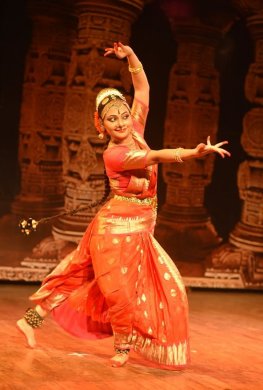 Abhinaya Nagajothy 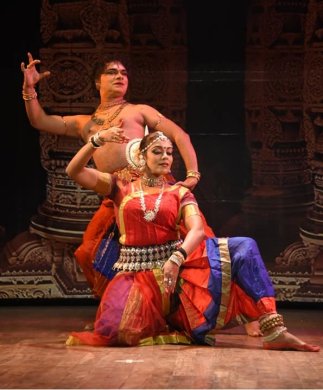 Ratheesh Babu & Sandhya Manoj Sandhya Manoj, an Odissi dancer based in Malaysia, and Ratheesh Babu, a student of Kalakshetra and Guru Adyar Lakshman, presented a duet on Ardhanari. The sahitya was based on Shankara's famous "Champeya gauraardha shareera kaayai…" hymn portraying the complementing Shiva- Parvati contrasts enshrined in one identity. The two dancers combined well particularly in the frozen postures one behind the other, speaking of having danced duets quite often. Ratheesh Babu as the Bharatanatyam Shiva was more into striking poses at the back, with Sandhya Manoj's sensuality overwhelming the rendition. While Sandhya's abhinaya flair comes out strongly, this critic found in her interpretation of Parvati, a certain petulance on odd occasions when she disagreed with Shiva, which for this critic took away from the mature dignity one would ascribe to Parvati even during disagreements with her husband. But the sringar feel was well captured. The music in ragamalika had ragas like Mohanam, Hindolam, Malkauns, and Sindhu Bhairavi. Sandeep Chakraborty, the young Kathak dancer, has been proving himself to be a talented dancer. He presented a sringar based work which has been covered in this column earlier. His command over rhythm is good and with his perfect ang, and above all with a willingness (unlike the general run of male dancers in Kathak) to deal with abhinaya, he is impressive to watch. And it is a welcome sign to see a Kathak dancer with a fine set of musicians in the accompaniment of percussion, vocal and instrumental support. A young dancer to watch out for! Shreyasi Gopinath impresses 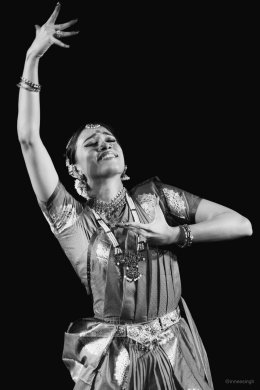 Shreyasi Gopinath (Photo: Innee Singh) A feature of the recital was the fine musical support led by Ragini Krishnan's very capable nattuvangam with Sudha Raghuraman's excellent singing. Chandrasekhar on mridangam and Raghuraman on the flute made up the small efficient team. The varnam without the right music can never evoke the required appeal. The undeniable Jamuna Krishnan feel came with the lyric rendered with special sensitivity, "Hari mera peev" the Kabir composition set to raga Durga by Jamuna herself along with her dance visualisation. Patnam Subramanya Iyer's "Mutta vaddura" had all the bite of the khandita who has had enough of her erring lover's broken promises. Jamuna's musicality was a significant aspect of her dance personality - and Shreyasi's tillana in raga Hamsanandi was also an example of both music and dance being contributed by the guru. A fitting tribute to a fond teacher. Remembering Parveen Gangani While on the subject of young dancers being encouraged, there was also an event designed to pay homage to a young departed dancer, Parveen Gangani. Dance homage to a departed guru concerned more than one programme in recent weeks. Ever since Parveen Gangani's accidental and sad demise, his family and 'gharanedhars' (heirs carrying the family tradition forward) have held a festival in his memory. Some of the Gangani family descendants residing in the capital are Mukesh Gangani (son), Ashish Gangani, Mahavir Gangani (pakhawaj), Manish Gangani, not to speak of the other line of Guru Rajendra Gangani, son of Kundanlal Gangani and his brother the ace percussionist tabla player Fateh Singh Gangani (the only one who as representative attended the event). This year's event on Nov 19 & 20 in a venue like the Kamani (when only a part of the auditorium could be filled with an audience) went over the top one felt and a more modest auditorium, apart from fulfilling the purpose would have looked much fuller. One drawback was the poor regard for the clock - with the show starting a bit late every evening and going on till beyond 9.30pm making it impossible for people coming from far off places to be viewers for the last two performances. Mukesh Gangani, son and disciple of Parveen Gangani, who opened the festival, has been very well trained and from the start with a Guru Namaskar to his teen taal nritta, he was a delight. Good presence, excellent 'ang', an agile physique which accommodates all types of demanding postures and movements like one legged chakkars, and different types of pirouettes in a Paran Amad ending with the Dhintadha Dhintadha syllables, the completely motionless body freezing on the sama, and ability to cover floor space almost effortlessly are some of the features of this youngster. The Misra jati tukra in Madhyalaya, the Sangeet Paran, the Kaliyadaman glimpse in the Krishna based intra form were all flawlessly executed. The tihai and Peir ke kaam were all rendered with ease. What Mukesh now needs is acquiring control on some interpretative dance and acquiring the compositional ability to present themes, wherein all the pure dance he has mastered can find place. The festival was a blend of junior dancers and very senior dance gurus - the one common point being an affinity with the departed Parveen Gangani. Parveen, despite his Jaipur gharana ancestry, also trained under Guru Birju Maharaj and as a much loved fellow dancer, some members of the Lucknow gharana fold also offered their dance in homage. Kathak runs in her blood 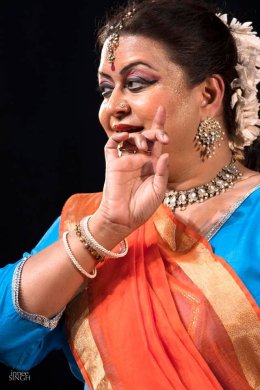 Mamta Maharaj (Photo: Innee Singh) By no means in her teens, wearing a loose gown to hide the not-so-slim body, and not particularly concerned with her physical appearance, Mamta Maharaj, daughter of Pt Birju Maharaj, proved that she has dance running in her veins. Every pore in her body has dance in it and each bit of movement acquires a special dimension in her Kathak. In her dance of sheer aesthetic appeal, dancing at jet speed or executing 30 and above chakkars has no meaning. Every movement speaks through her body and in the upaj section and Amad, the rhythmic syllables in the way they were arranged had artistry. The Uthan and Paran Amad, the 'Dhataka Thunga', the way her torso swivels, visibly showing the grace of a rhythmic syllable travelling through her - everything about Mamta shows that she has her father's gene working in her strongly. The quick abhinaya woven round her father's poetic composition "Mylee Manmohan manbhai" saw that understanding of expressional dance which comes naturally to one who is so sensitive to all aspects of Kathak. Jai Dhadheej sang in soft melody and altogether, I felt that what one saw was distilled beauty of the dance, from a dancer to whom Kathak comes as a natural body language. On the tabla was Abhishek Gangani, brother of Mukesh Gangani. Komal, the first girl in the family who danced, gave a performance which while correct did not live up to what one expected from one who had learnt for well nigh 12 years, with the Tika (ornament on the hairline with the pendant decorating the forehead) on her forehead flying all over the place (more often to one side of the face) as she danced. 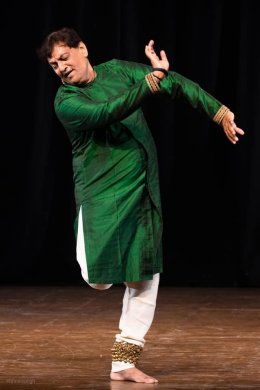 Jagdish Gangani 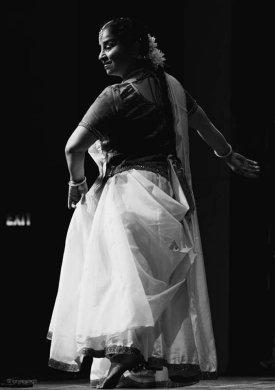 Jayashree Acharya Jagdish Gangani, son of Sunderlal Gangani, dancing for the first time after a five year retirement from stage performances, as a tribute to Parveen Gangani, very naturally had to have halts in his presentation to gather steam, with his body out of practice. But in the impeccable time measurement and freezing, one could sense the proficient dancer. The composition woven out of the five tatwas (cosmic elements), each symbolised in onomatopoeic rhythmic syllable, was very innovative. He ended with Sunderlal Gangani's Govardhana Lila. Jayashree Acharya, a senior disciple of Guru Birju Maharaj, just started her teental Madhya laya when the late hour made it difficult for many like this critic to remain for the performance. Similarly one missed recital of Krishan Maharaj the day before. Sitting next to Parveen Gangani's sister, one got a feel of the close family ties amongst these families - which helped in the long run, in preserving gharana legacy from one generation to the next. Parveen by trying to acquire some of the Lucknow gharana flavour, though frowned upon by the family, remains in their memories as a fond and highly talented relative. Kathak Disha, the school started by Parveen, is being looked after by the sons and relatives.  Writing on the dance scene for the last forty years, Leela Venkataraman's incisive comments on performances of all dance forms, participation in dance discussions both in India and abroad, and as a regular contributor to Hindu Friday Review, journals like Sruti and Nartanam, makes her voice respected for its balanced critiquing. She is the author of several books like Indian Classical dance: Tradition in Transition, Classical Dance in India and Indian Classical dance: The Renaissance and Beyond. Post your comments Please provide your name and email id when you use the Anonymous profile in the blog to post a comment. All appropriate comments posted with name and email id in the blog will also be featured in the site. |